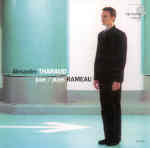Rameau on piano? Aren’t Rameau’s tactile syntax and ornamental surface style necessarily instrument-specific (meaning, of course, the harpsichord), whereas Bach’s “universal” language can be applied to any keyboard instrument? Well, don’t you believe that hooey for a second. If you can nail the ornaments, bring out the architecture, and make the music sing, dance, and breathe, I’d rather hear a thoughtful, accomplished pianist such as Alexandre Tharaud in the A major and G major suites than a boring harpsichordist–and conversely. Tharaud partakes in updated performance conventions, such as varying the repeats and observing double-dotted rhythms in the A major’s opening Allemande, yet he doesn’t make scholarship the issue. He keeps the music’s linear qualities afloat and varied with a mellow touch and a discreet foot on the sustain pedal.
Notice, for instance, Tharaud’s grounded runs and deft transitions throughout the A major suite’s Gavotte and variations. Comparisons with Marcelle Meyer’s fabled 1953 Rameau piano recordings, however, reveal the older pianist’s more cogently-projected bass lines, stronger sense of upbeat and forward momentum, and more tang to the composer’s dissonances. Hear how Meyer stresses the intrinsic metric shifts in “Les Tricotets” with peppery accents, whereas Tharaud hardly varies his articulation. I even prefer Meyer’s mono engineering, so whiskery and robust next to Harmonia Mundi’s softer-grained halo of resonance. Lastly, Tharaud’s accurate, respectful, yet somewhat staid traversal of Debussy’s Hommage à Rameau must yield to the virile, full-toned, and red blooded accounts from Moravec, Rubinstein, and Michelangeli. If Rameau on the concert grand is your cup of tea, Tharaud’s lovely playing will please you, but only if you temporarily erase Marcelle Meyer’s genius from your memory bank.
































